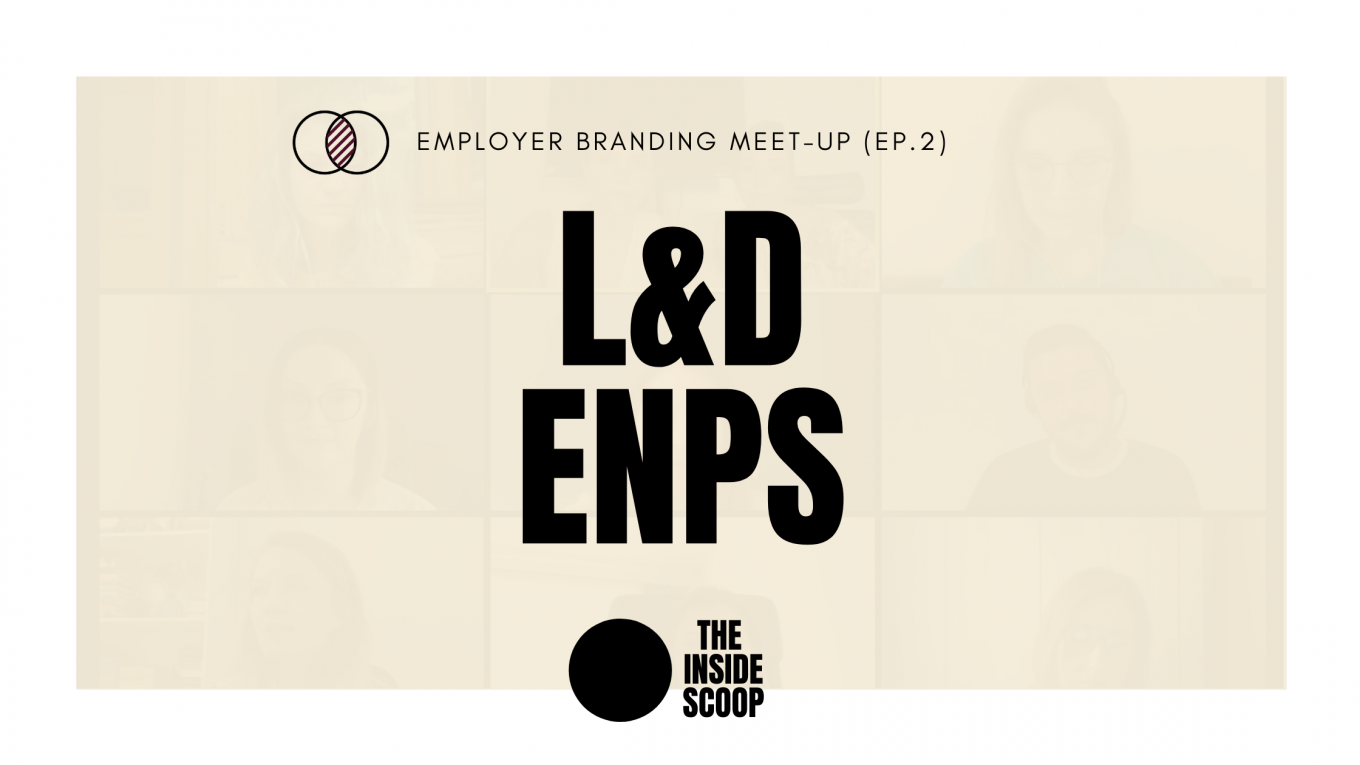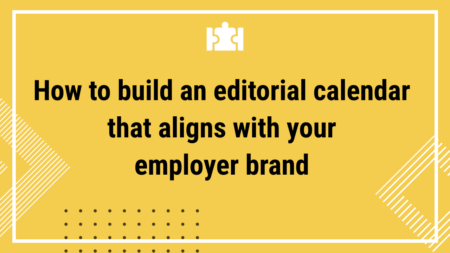It’s no secret that employee engagement and employer branding are connected. Engaged employees are more productive, happier, and more likely to become brand advocates. That being said, one of the most powerful strategies to increase (and preserve) engagement is by providing your people with learning and development (L&D) opportunities.
Did you know that it costs between 16% and 20% of a role’s annual salary to replace someone? Replacing an executive can cost even more, up to 200% of the annual salary. Facebook employees, for example, leave when they’re no longer happy; when they feel their work is no longer enjoyable and their core competencies are ignored (HBR). Learning and development programs don’t just improve engagement but also your employer brand, offering workers an opportunity to hone and perfect their skills or learn new ones from scratch.
We recently ended our second monthly meet-up and we’re more than happy to share with you what we’ve discussed, debated, and learned on two very interesting topics: learning and development (L&D) and eNPS (employee net promoter score), and how they relate to employer branding. A big thank you to this edition’s speakers, Alecsandra and Letitia!
The importance of learning & development
Now, more than ever, companies rely on the creativity, spirit, and skills of its people. That’s one of the main reasons “talent” is associated with “employee” these days. Because we live in a digital realm that gets smarter with every day that goes by, organizations feel the pressure to become more innovative to stay competitive. They want – and expect – change to happen fast.
Technology-assisted teaching has skyrocketed in the past 5 years, doubling the number of technologies used by learning and development (L&D) departments. According to Statista, 71% of companies reported that tech-enabled teaching (e.g. online training) is one of their most-used strategies. The problem is, not all employees are comfortable with the digital. Over 50% prefer face-to-face training and learning via one-on-one or group sessions.
L&D challenges
Whether physical or virtual, training alone doesn’t do much. Truth be told, a whopping 75% of company managers are unhappy with the results offered by an L&D program because only 12% of their employees actually apply what they learn. There are lots of reasons L&D doesn’t work and it’s not because the program is not good. It is because change doesn’t happen overnight.
“1-day, 7-day, 14-day training programs don’t work when employees are resistant to change. For L&D to render results, your people should – at the very least – be open to the idea of change and making progress to become more productive.” (Alecsandra Botosaneanu, Learning & Development Manager la Mood Media)
In theory, a training program sounds awesome. It does instill a sense of willingness to get things going, do better, work harder. In reality, a very small number of attendees will actually put into practice what they’ve learned to change their behavior.
Following an L&D program, it’s natural for the company to want to see results. And they don’t because L&D is not a fast-paced voodoo magic program that hypnotizes employees with a few sessions and turns them into superheroes. Real L&D is a detailed process divided into 4 core stages, also known as the Kirkpatrick Evaluation Model. A breakdown of how things unfold:
- Level 1 (Reaction): following the first training session, attendees are given an initial survey where they’re asked to evaluate the training.
- Level 2 (Learning): This is where the trainer asks attendees questions from what was taught in Level 1 to verify if his/her knowledge was successfully transferred onto the participants
- Level 3 (Behavioral Change): This is where the trainer follows up with the attendees and can actually measure whether or not they’ve changed in behavior.
- Level 4 (Results): aka “the holy grail of learning” that measures the impact the training program had on a business level.
Levels 1 and 2 are attainable because, in general, employees like it when their companies invest in their professional growth. Such programs make them feel empowered, however, Levels 3 and 4 from the Kirkpatrick Evaluation Model are really hard to beat.
With time, attendees will get back to their old routine because, as Charles Duhigg writes it in The Power of Habit, “to modify a habit, you must decide to change it. You must consciously accept the hard work of identifying the cues and rewards that drive the habits’ routines, and find alternatives.”
Actions to take: solutions to make L&D efficient
How do you make L&D programs work within your company? What needs to be done for your employees to be more productive after a training program? For starters, it is important to get all managers and leaders involved in the process and make them realize that they have a very important role within your company. Once they become aware that your success depends on the success of a learning program, the learning per se part becomes a collaborative partnership.
Support and constant feedback between managers who attended the same training, and follow-ups between managers and trainers paves the way to creating an orchestrated learning experience that renders results at the business level.
“If we don’t brainstorm a series of interventions (exercises, challenges, quizzes, follow-up meetings with the participants) following the end of a training program, what was delivered in the training won’t stick.” (Alecsandra Botosaneanu, Learning & Development Manager la Mood Media)

eNPS, company culture, and employee engagement
L&D programs done right can skyrocket your company’s ROI. When managers and employees are aligned, productivity abounds, money flows in, and everyone’s happy. But before jumping to the conclusion that your organization is the best place to work on the planet, you should measure that level of happiness. This can be done by assessing your organization’s eNPS.
Dubbed “Employee Net Promoter Score”, eNPS is a metric used to measure employee satisfaction against employee experience. In simple terms, it answers the following question “On a scale of 0 to 10, how likely are you to recommend our organization to others?” followed by “Why did you choose this score?”

The results you get might look like this:
-100 & 0: “I hate my job!” said by all of your employees
0 & 50: “Whatever, I don’t care.”
50 & 70: “Love it, but I could use a gym pass.”
70 & 100: “I want to move to the office.”
Ideally, you should aim for a score above 70 as it tells you that your employees are not just happy because you pay them well, but also because the work they do matters and you have a well-thought company culture.
A little disclaimer on what an eNPS is not: eNPS is not a direct employee engagement metric. It takes your company’s temperature, but it doesn’t tell why you are healthy or sick.
In terms of frequency, the ideal time frame to take the “pulse” is quarterly. Yearly evaluations of your eNPS are too rare as many things can change in 12 months (e.g. some or more employees may leave in the meantime, new people entering the organization may love you in December and hate you in February). As for progress and genuine evaluations at an organizational level, when done every 3 to 4 months, it provides a more realistic overview of your company’s “temperature”.
eNPS – a challenging process, but vital for business
By transforming your eNPS into a continuous process you’ll be given the opportunity to assess your organization’s vibe with more precision. But then again, the challenge with surveys is that most companies don’t make the extra effort to stick to them. They favor the 15-minute (completely irrelevant) employee survey done at the end of the year. This also translates into the company’s disinterest in making improvements and taking some form of action to boost employee satisfaction and, at the same time, productivity.
Organizations that care about their employees are not afraid to “spam” them with surveys meant to improve their wellbeing at work. It’s all about communicating the purpose with your people, explaining to them “Hey, we’re doing this for you, so bear with us”.
For example, an eNPS survey (that only takes 30 seconds) done by-monthly over the course of 12 months will help you observe progress over a longer period of time. By making it a continuous process, you’ll have the chance to see how it fluctuates, indicating the way you – as a company – are perceived by your people.
eNPS analysis, context, and limitations
Every business unit within an organization deals with different experiences. On a broader scale, working at Google is fine as Google has an overall eNPS of 42. At a branch level (e.g. HR, sales, development) some people could be either incredibly happy or downright angry due to different circumstances they deal with every single day.
“eNPS is not a standalone mechanism for understanding employee engagement as it can be misleading. It is possible to have jobs/business sectors where the daily working schedule allows employees to play Solitaire without anyone knowing what they’re actually doing. That doesn’t translate to a “cool” place to work as those employees are relaxed, not engaged. They don’t necessarily relate to the company’s values and they might recommend your company as being “amazing” just because it’s a stress-free environment where they don’t have to do much.” (Letitia Stefan, Co-Founder & CEO @Nifty Learning, a Techstars company)
To understand the result your company got following an eNPS survey, it is important to analyze the answers from open-end questions. Be advised that the survey alone won’t capture the whole working experience of your employees. Your goal should be to find the reason – WHY did your people give you the score? This way you’ll acknowledge how engaged employees are.
Sometimes it’s even better to chase the bad scores as they might hide easy solutions: better coffee, new AC, etc. But then again, asking them to fill 5 eNPS surveys per year and doing nothing about their pain points is bad, as people might start believing that you’re “watching” them and don’t really care about how they feel at work.
Bottom line
Both learning and development (L&D) programs and eNPS surveys matter in business when the ultimate goal is to build a strong employer brand. SendGrid, for example, has a well-defined corporate culture that abides by “4Hs – Happy, Hungry, Humble, and Honest”. Their eNPS is 83 because they’ve become known for promoting a company culture around people, aka their “Gridders”.
Now, more than ever, companies of all shapes and sizes should pay more attention to the people they work with. The more you care about them, the better chances you have to see long-term results at the organizational level.






